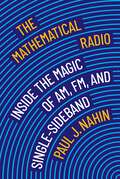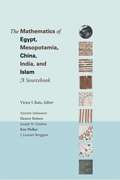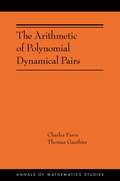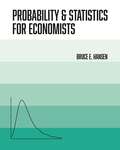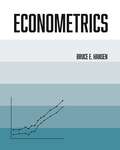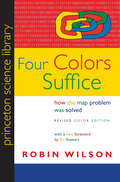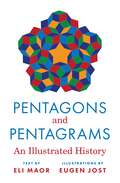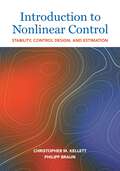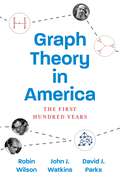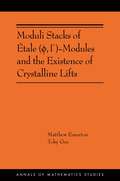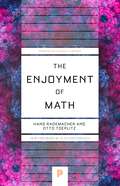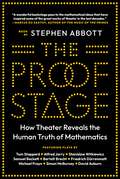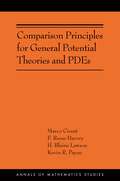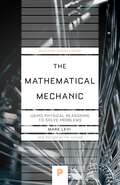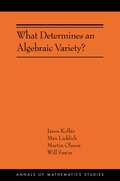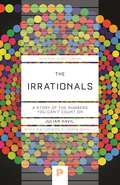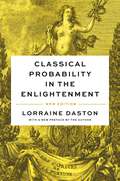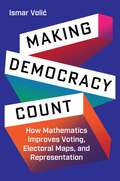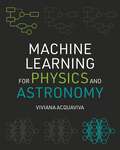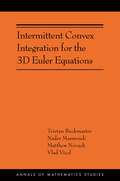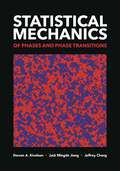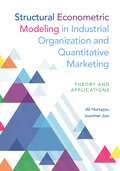- Table View
- List View
The Mathematical Radio: Inside the Magic of AM, FM, and Single-Sideband
by Paul J. NahinHow a modern radio works, told through mathematics, history, and selected puzzlesThe modern radio is a wonder, and behind that magic is mathematics. In The Mathematical Radio, Paul Nahin explains how radios work, deploying mathematics and historical discussion, accompanied by a steady stream of intriguing puzzles for math buffs to ponder. Beginning with oscillators and circuits, then moving on to AM, FM, and single-sideband radio, Nahin focuses on the elegant mathematics underlying radio technology rather than the engineering. He explores and explains more than a century of key developments, placing them in historical and technological context.Nahin, a prolific author of books on math for the general reader, describes in fascinating detail the mathematical underpinnings of a technology we use daily. He explains and solves, for example, Maxwell&’s equations for the electromagnetic field. Readers need only a familarity with advanced high school–level math to follow Nahin&’s mathematical discussions. Writing with the nonengineer in mind, Nahin examines topics including impulses in time and frequency, spectrum shifting at the transmitter, the superheterodyne, the physics of single-sideband radio, and FM sidebands. Chapters end with &“challenge problems&” and an appendix offers solutions, partial answers, and hints. Readers will come away with a new appreciation for the beauty of even the most useful mathematics.
The Mathematics of Egypt, Mesopotamia, China, India, and Islam: A Sourcebook
by Kim Plofker Annette Imhausen Joseph Warren Dauben J. Lennart Berggren Eleanor RobsonIn recent decades it has become obvious that mathematics has always been a worldwide activity. But this is the first book to provide a substantial collection of English translations of key mathematical texts from the five most important ancient and medieval non-Western mathematical cultures, and to put them into full historical and mathematical context. The Mathematics of Egypt, Mesopotamia, China, India, and Islam gives English readers a firsthand understanding and appreciation of these cultures' important contributions to world mathematics. The five section authors--Annette Imhausen (Egypt), Eleanor Robson (Mesopotamia), Joseph Dauben (China), Kim Plofker (India), and J. Lennart Berggren (Islam)--are experts in their fields. Each author has selected key texts and in many cases provided new translations. The authors have also written substantial section introductions that give an overview of each mathematical culture and explanatory notes that put each selection into context. This authoritative commentary allows readers to understand the sometimes unfamiliar mathematics of these civilizations and the purpose and significance of each text. Addressing a critical gap in the mathematics literature in English, this book is an essential resource for anyone with at least an undergraduate degree in mathematics who wants to learn about non-Western mathematical developments and how they helped shape and enrich world mathematics. The book is also an indispensable guide for mathematics teachers who want to use non-Western mathematical ideas in the classroom.
The Arithmetic of Polynomial Dynamical Pairs: (AMS-214) (Annals of Mathematics Studies #401)
by Charles Favre Thomas GauthierNew mathematical research in arithmetic dynamicsIn The Arithmetic of Polynomial Dynamical Pairs, Charles Favre and Thomas Gauthier present new mathematical research in the field of arithmetic dynamics. Specifically, the authors study one-dimensional algebraic families of pairs given by a polynomial with a marked point. Combining tools from arithmetic geometry and holomorphic dynamics, they prove an “unlikely intersection” statement for such pairs, thereby demonstrating strong rigidity features for them. They further describe one-dimensional families in the moduli space of polynomials containing infinitely many postcritically finite parameters, proving the dynamical André-Oort conjecture for curves in this context, originally stated by Baker and DeMarco.This is a reader-friendly invitation to a new and exciting research area that brings together sophisticated tools from many branches of mathematics.
Probability and Statistics for Economists
by Bruce HansenA comprehensive and up-to-date introduction to the mathematics that all economics students need to knowProbability theory is the quantitative language used to handle uncertainty and is the foundation of modern statistics. Probability and Statistics for Economists provides graduate and PhD students with an essential introduction to mathematical probability and statistical theory, which are the basis of the methods used in econometrics. This incisive textbook teaches fundamental concepts, emphasizes modern, real-world applications, and gives students an intuitive understanding of the mathematics that every economist needs to know.Covers probability and statistics with mathematical rigor while emphasizing intuitive explanations that are accessible to economics students of all backgroundsDiscusses random variables, parametric and multivariate distributions, sampling, the law of large numbers, central limit theory, maximum likelihood estimation, numerical optimization, hypothesis testing, and moreFeatures hundreds of exercises that enable students to learn by doingIncludes an in-depth appendix summarizing important mathematical results as well as a wealth of real-world examplesCan serve as a core textbook for a first-semester PhD course in econometrics and as a companion book to Bruce E. Hansen’s EconometricsAlso an invaluable reference for researchers and practitioners
Econometrics
by Bruce HansenThe most authoritative and up-to-date core econometrics textbook availableEconometrics is the quantitative language of economic theory, analysis, and empirical work, and it has become a cornerstone of graduate economics programs. Econometrics provides graduate and PhD students with an essential introduction to this foundational subject in economics and serves as an invaluable reference for researchers and practitioners. This comprehensive textbook teaches fundamental concepts, emphasizes modern, real-world applications, and gives students an intuitive understanding of econometrics.Covers the full breadth of econometric theory and methods with mathematical rigor while emphasizing intuitive explanations that are accessible to students of all backgroundsDraws on integrated, research-level datasets, provided on an accompanying websiteDiscusses linear econometrics, time series, panel data, nonparametric methods, nonlinear econometric models, and modern machine learningFeatures hundreds of exercises that enable students to learn by doingIncludes in-depth appendices on matrix algebra and useful inequalities and a wealth of real-world examplesCan serve as a core textbook for a first-year PhD course in econometrics and as a follow-up to Bruce E. Hansen’s Probability and Statistics for Economists
Four Colors Suffice: How the Map Problem Was Solved - Revised Color Edition (Princeton Science Library #128)
by Robin WilsonOn October 23, 1852, Professor Augustus De Morgan wrote a letter to a colleague, unaware that he was launching one of the most famous mathematical conundrums in history--one that would confound thousands of puzzlers for more than a century. This is the amazing story of how the "map problem" was solved. The problem posed in the letter came from a former student: What is the least possible number of colors needed to fill in any map (real or invented) so that neighboring counties are always colored differently? This deceptively simple question was of minimal interest to cartographers, who saw little need to limit how many colors they used. But the problem set off a frenzy among professional mathematicians and amateur problem solvers, among them Lewis Carroll, an astronomer, a botanist, an obsessive golfer, the Bishop of London, a man who set his watch only once a year, a California traffic cop, and a bridegroom who spent his honeymoon coloring maps. In their pursuit of the solution, mathematicians painted maps on doughnuts and horseshoes and played with patterned soccer balls and the great rhombicuboctahedron. It would be more than one hundred years (and countless colored maps) later before the result was finally established. Even then, difficult questions remained, and the intricate solution--which involved no fewer than 1,200 hours of computer time--was greeted with as much dismay as enthusiasm. Providing a clear and elegant explanation of the problem and the proof, Robin Wilson tells how a seemingly innocuous question baffled great minds and stimulated exciting mathematics with far-flung applications. This is the entertaining story of those who failed to prove, and those who ultimately did prove, that four colors do indeed suffice to color any map. This new edition features many color illustrations. It also includes a new foreword by Ian Stewart on the importance of the map problem and how it was solved.
Pentagons and Pentagrams: An Illustrated History
by Eli Maor Eugen JostA fascinating exploration of the pentagon and its role in various culturesThe pentagon and its close cousin, the pentagram, have inspired individuals for the last two and half millennia, from mathematicians and philosophers to artists and naturalists. Despite the pentagon’s wide-ranging history, no single book has explored the important role of this shape in various cultures, until now. Richly illustrated, Pentagons and Pentagrams offers a sweeping view of the five-sided polygon, revealing its intriguing geometric properties and its essential influence on a variety of fields.Traversing time, Eli Maor narrates vivid stories, both celebrated and unknown, about the pentagon and pentagram. He discusses the early Pythagoreans, who ascribed to the pentagon mythical attributes, adopted it as their emblem, and figured out its construction with a straightedge and compass. Maor looks at how a San Diego housewife uncovered four previously unknown types of pentagonal tilings, and how in 1982 a scientist’s discovery of fivefold symmetries in certain alloys caused an uproar in crystallography and led to a Nobel Prize. Maor also discusses the pentagon’s impact on many buildings, from medieval fortresses to the Pentagon in Washington, D.C. Eugen Jost’s superb illustrations provide sumptuous visual context, and the book’s puzzles and mazes offer fun challenges for readers, with solutions given in an appendix.
Introduction to Nonlinear Control: Stability, Control Design, and Estimation
by Christopher M. Kellett Philipp BraunAn introductory text on the analysis, control, and estimation of nonlinear systems, appropriate for advanced undergraduate and graduate studentsThis self-contained and accessible introduction to the concepts and techniques used for nonlinear feedback systems offers a holistic treatment suitable for use in both advanced undergraduate and graduate courses; students need only some familiarity with differential equations and linear algebra to understand the material presented. The text begins with an overview of stability and Lyapunov methods for nonlinear systems, with Lyapunov’s second method revisited throughout the book as a connective thread. Other introductory chapters cover linear systems, frequency domain methods, and discrete-time systems. Building on this background material, the book provides a broad introduction to the basic ideas underpinning major themes of research in nonlinear control, including input-to-state stability, sliding mode control, adaptive control, feedback linearization, and robust output regulation. Chapters also cover observer design and estimation for nonlinear systems. The text is notable for its coverage of nonlinear model predictive control and its introduction to the use of linear matrix inequalities and semidefinite programming coupled with their use in modern antiwindup designs.• First text on nonlinear control appropriate for undergraduates• Suitable both for students preparing for rigorous graduate study and for those entering technical fields outside of academia• Unique in its coverage of recent research topics• Pedagogical features including extensive chapter summaries, examples, and appendixes with definitions, results, and MATLAB applications
Graph Theory in America: The First Hundred Years
by Robin Wilson John J. Watkins David J. ParksHow a new mathematical field grew and matured in America Graph Theory in America focuses on the development of graph theory in North America from 1876 to 1976. At the beginning of this period, James Joseph Sylvester, perhaps the finest mathematician in the English-speaking world, took up his appointment as the first professor of mathematics at the Johns Hopkins University, where his inaugural lecture outlined connections between graph theory, algebra, and chemistry—shortly after, he introduced the word graph in our modern sense. A hundred years later, in 1976, graph theory witnessed the solution of the long-standing four color problem by Kenneth Appel and Wolfgang Haken of the University of Illinois.Tracing graph theory’s trajectory across its first century, this book looks at influential figures in the field, both familiar and less known. Whereas many of the featured mathematicians spent their entire careers working on problems in graph theory, a few such as Hassler Whitney started there and then moved to work in other areas. Others, such as C. S. Peirce, Oswald Veblen, and George Birkhoff, made excursions into graph theory while continuing their focus elsewhere. Between the main chapters, the book provides short contextual interludes, describing how the American university system developed and how graph theory was progressing in Europe. Brief summaries of specific publications that influenced the subject’s development are also included.Graph Theory in America tells how a remarkable area of mathematics landed on American soil, took root, and flourished.
Moduli Stacks of Étale: (AMS-215) (Annals Of Mathematics Studies #408)
by Matthew Emerton Toby GeeA foundational account of a new construction in the p-adic Langlands correspondenceMotivated by the p-adic Langlands program, this book constructs stacks that algebraize Mazur’s formal deformation rings of local Galois representations. More precisely, it constructs Noetherian formal algebraic stacks over Spf Zp that parameterize étale (ϕ, Γ)-modules; the formal completions of these stacks at points in their special fibres recover the universal deformation rings of local Galois representations. These stacks are then used to show that all mod p representations of the absolute Galois group of a p-adic local field lift to characteristic zero, and indeed admit crystalline lifts. The book explicitly describes the irreducible components of the underlying reduced substacks and discusses the relationship between the geometry of these stacks and the Breuil–Mézard conjecture. Along the way, it proves a number of foundational results in p-adic Hodge theory that may be of independent interest.
The Enjoyment of Math (Princeton Science Library #138)
by Hans Rademacher Otto ToeplitzThe classic book that shares the enjoyment of mathematics with readers of all skill levelsWhat is so special about the number 30? Do the prime numbers go on forever? Are there more whole numbers than even numbers? The Enjoyment of Math explores these and other captivating problems and puzzles, introducing readers to some of the most fundamental ideas in mathematics. Written by two eminent mathematicians and requiring only a background in plane geometry and elementary algebra, this delightful book covers topics such as the theory of sets, the four-color problem, regular polyhedrons, Euler’s proof of the infinitude of prime numbers, and curves of constant breadth. Along the way, it discusses the history behind the problems, carefully explaining how each has arisen and, in some cases, how to resolve it. With an incisive foreword by Alex Kontorovich, this Princeton Science Library edition shares the enjoyment of math with a new generation of readers.
The Proof Stage: How Theater Reveals the Human Truth of Mathematics
by Stephen AbbottHow playwrights from Alfred Jarry and Samuel Beckett to Tom Stoppard and Simon McBurney brought the power of abstract mathematics to the human stageThe discovery of alternate geometries, paradoxes of the infinite, incompleteness, and chaos theory revealed that, despite its reputation for certainty, mathematical truth is not immutable, perfect, or even perfectible. Beginning in the last century, a handful of adventurous playwrights took inspiration from the fractures of modern mathematics to expand their own artistic boundaries. Originating in the early avant-garde, mathematics-infused theater reached a popular apex in Tom Stoppard’s 1993 play Arcadia. In The Proof Stage, mathematician Stephen Abbott explores this unlikely collaboration of theater and mathematics. He probes the impact of mathematics on such influential writers as Alfred Jarry, Samuel Beckett, Bertolt Brecht, and Stoppard, and delves into the life and mathematics of Alan Turing as they are rendered onstage. The result is an unexpected story about the mutually illuminating relationship between proofs and plays—from Euclid and Euripides to Gödel and Godot.Theater is uniquely poised to discover the soulful, human truths embedded in the austere theorems of mathematics, but this is a difficult feat. It took Stoppard twenty-five years of experimenting with the creative possibilities of mathematics before he succeeded in making fractal geometry and chaos theory integral to Arcadia’s emotional arc. In addition to charting Stoppard’s journey, Abbott examines the post-Arcadia wave of ambitious works by Michael Frayn, David Auburn, Simon McBurney, Snoo Wilson, John Mighton, and others. Collectively, these gifted playwrights transform the great philosophical upheavals of mathematics into profound and sometimes poignant revelations about the human journey.
Comparison Principles for General Potential Theories and PDEs: (AMS-218) (Annals of Mathematics Studies #218)
by Marco Cirant F. Reese Harvey H. Blaine Lawson Kevin R. PayneAn examination of the symbiotic and productive relationship between fully nonlinear partial differential equations and generalized potential theoriesIn recent years, there has evolved a symbiotic and productive relationship between fully nonlinear partial differential equations and generalized potential theories. This book examines important aspects of this story. One main purpose is to prove comparison principles for nonlinear potential theories in Euclidian spaces straightforwardly from duality and monotonicity under the weakest possible notion of ellipticity. The book also shows how to deduce comparison principles for nonlinear differential operators, by marrying these two points of view, under the correspondence principle.The authors explain that comparison principles are fundamental in both contexts, since they imply uniqueness for the Dirichlet problem. When combined with appropriate boundary geometries, yielding suitable barrier functions, they also give existence by Perron’s method. There are many opportunities for cross-fertilization and synergy. In potential theory, one is given a constraint set of 2-jets that determines its subharmonic functions. The constraint set also determines a family of compatible differential operators. Because there are many such operators, potential theory strengthens and simplifies the operator theory. Conversely, the set of operators associated with the constraint can influence the potential theory.
The Mathematical Mechanic: Using Physical Reasoning to Solve Problems (Princeton Science Library #139)
by Mark LeviEverybody knows that mathematics is indispensable to physics--imagine where we'd be today if Einstein and Newton didn't have the math to back up their ideas. But how many people realize that physics can be used to produce many astonishing and strikingly elegant solutions in mathematics? Mark Levi shows how in this delightful book, treating readers to a host of entertaining problems and mind-bending puzzlers that will amuse and inspire their inner physicist.Levi turns math and physics upside down, revealing how physics can simplify proofs and lead to quicker solutions and new theorems, and how physical solutions can illustrate why results are true in ways lengthy mathematical calculations never can. Did you know it's possible to derive the Pythagorean theorem by spinning a fish tank filled with water? Or that soap film holds the key to determining the cheapest container for a given volume? Or that the line of best fit for a data set can be found using a mechanical contraption made from a rod and springs? Levi demonstrates how to use physical intuition to solve these and other fascinating math problems. More than half the problems can be tackled by anyone with precalculus and basic geometry, while the more challenging problems require some calculus. This one-of-a-kind book explains physics and math concepts where needed, and includes an informative appendix of physical principles.The Mathematical Mechanic will appeal to anyone interested in the little-known connections between mathematics and physics and how both endeavors relate to the world around us.
What Determines an Algebraic Variety?: (AMS-216) (Annals of Mathematics Studies #216)
by János Kollár Max Lieblich Martin Olsson Will SawinA pioneering new nonlinear approach to a fundamental question in algebraic geometryOne of the crowning achievements of nineteenth-century mathematics was the proof that the geometry of lines in space uniquely determines the Cartesian coordinates, up to a linear ambiguity. What Determines an Algebraic Variety? develops a nonlinear version of this theory, offering the first nonlinear generalization of the seminal work of Veblen and Young in a century. While the book uses cutting-edge techniques, the statements of its theorems would have been understandable a century ago; despite this, the results are totally unexpected. Putting geometry first in algebraic geometry, the book provides a new perspective on a classical theorem of fundamental importance to a wide range of fields in mathematics.Starting with basic observations, the book shows how to read off various properties of a variety from its geometry. The results get stronger as the dimension increases. The main result then says that a normal projective variety of dimension at least 4 over a field of characteristic 0 is completely determined by its Zariski topological space. There are many open questions in dimensions 2 and 3, and in positive characteristic.
The Irrationals: A Story of the Numbers You Can't Count On (Princeton Science Library #134)
by Julian HavilAn entertaining and enlightening history of irrational numbers, from ancient Greece to the twenty-first centuryThe ancient Greeks discovered them, but it wasn't until the nineteenth century that irrational numbers were properly understood and rigorously defined, and even today not all their mysteries have been revealed. In The Irrationals, the first popular and comprehensive book on the subject, Julian Havil tells the story of irrational numbers and the mathematicians who have tackled their challenges, from antiquity to the twenty-first century. Along the way, he explains why irrational numbers are surprisingly difficult to define—and why so many questions still surround them. Fascinating and illuminating, this is a book for everyone who loves math and the history behind it.
Classical Probability in the Enlightenment, New Edition
by Lorraine DastonAn award-winning history of the Enlightenment quest to devise a mathematical model of rationalityWhat did it mean to be reasonable in the Age of Reason? Enlightenment mathematicians such as Blaise Pascal, Jakob Bernoulli, and Pierre Simon Laplace sought to answer this question, laboring over a theory of rational decision, action, and belief under conditions of uncertainty. Lorraine Daston brings to life their debates and philosophical arguments, charting the development and application of probability theory by some of the greatest thinkers of the age. Now with an incisive new preface, Classical Probability in the Enlightenment traces the emergence of new kind of mathematics designed to turn good sense into a reasonable calculus.
Classical Probability in the Enlightenment, New Edition
by Lorraine DastonAn award-winning history of the Enlightenment quest to devise a mathematical model of rationalityWhat did it mean to be reasonable in the Age of Reason? Enlightenment mathematicians such as Blaise Pascal, Jakob Bernoulli, and Pierre Simon Laplace sought to answer this question, laboring over a theory of rational decision, action, and belief under conditions of uncertainty. Lorraine Daston brings to life their debates and philosophical arguments, charting the development and application of probability theory by some of the greatest thinkers of the age. Now with an incisive new preface, Classical Probability in the Enlightenment traces the emergence of new kind of mathematics designed to turn good sense into a reasonable calculus.
Making Democracy Count: How Mathematics Improves Voting, Electoral Maps, and Representation
by Ismar VolićHow we can repair our democracy by rebuilding the mechanisms that power itWhat’s the best way to determine what most voters want when multiple candidates are running? What’s the fairest way to allocate legislative seats to different constituencies? What’s the least distorted way to draw voting districts? Not the way we do things now. Democracy is mathematical to its very foundations. Yet most of the methods in use are a historical grab bag of the shortsighted, the cynical, the innumerate, and the outright discriminatory. Making Democracy Count sheds new light on our electoral systems, revealing how a deeper understanding of their mathematics is the key to creating civic infrastructure that works for everyone.In this timely guide, Ismar Volić empowers us to use mathematical thinking as an objective, nonpartisan framework that rises above the noise and rancor of today’s divided public square. Examining our representative democracy using powerful clarifying concepts, Volić shows why our current voting system stifles political diversity, why the size of the House of Representatives contributes to its paralysis, why gerrymandering is a sinister instrument that entrenches partisanship and disenfranchisement, why the Electoral College must be rethought, and what can work better and why. Volić also discusses the legal and constitutional practicalities involved and proposes a road map for repairing the mathematical structures that undergird representative government.Making Democracy Count gives us the concrete knowledge and the confidence to advocate for a more just, equitable, and inclusive democracy.
Engage and Evade: How Latino Immigrant Families Manage Surveillance in Everyday Life
by Asad L. AsadHow everyday forms of surveillance threaten undocumented immigrants—but also offer them hope for societal inclusionSome eleven million undocumented immigrants reside in the United States, carving out lives amid a growing web of surveillance that threatens their and their families’ societal presence. Engage and Evade examines how undocumented immigrants navigate complex dynamics of surveillance and punishment, providing an extraordinary portrait of fear and hope on the margins.Asad L. Asad brings together a wealth of research, from intimate interviews and detailed surveys with Latino immigrants and their families to up-close observations of immigration officials, to offer a rare perspective on the surveillance that undocumented immigrants encounter daily. He describes how and why these immigrants engage with various institutions—for example, by registering with the IRS or enrolling their kids in public health insurance programs—that the government can use to monitor them. This institutional surveillance feels both necessary and coercive, with undocumented immigrants worrying that evasion will give the government cause to deport them. Even so, they hope their record of engagement will one day help them prove to immigration officials that they deserve societal membership. Asad uncovers how these efforts do not always meet immigration officials’ high expectations, and how surveillance is as much about the threat of exclusion as the promise of inclusion.Calling attention to the fraught lives of undocumented immigrants and their families, this superbly written and compassionately argued book proposes wide-ranging, actionable reforms to achieve societal inclusion for all.
Engage and Evade: How Latino Immigrant Families Manage Surveillance in Everyday Life
by Asad L. AsadHow everyday forms of surveillance threaten undocumented immigrants—but also offer them hope for societal inclusionSome eleven million undocumented immigrants reside in the United States, carving out lives amid a growing web of surveillance that threatens their and their families’ societal presence. Engage and Evade examines how undocumented immigrants navigate complex dynamics of surveillance and punishment, providing an extraordinary portrait of fear and hope on the margins.Asad L. Asad brings together a wealth of research, from intimate interviews and detailed surveys with Latino immigrants and their families to up-close observations of immigration officials, to offer a rare perspective on the surveillance that undocumented immigrants encounter daily. He describes how and why these immigrants engage with various institutions—for example, by registering with the IRS or enrolling their kids in public health insurance programs—that the government can use to monitor them. This institutional surveillance feels both necessary and coercive, with undocumented immigrants worrying that evasion will give the government cause to deport them. Even so, they hope their record of engagement will one day help them prove to immigration officials that they deserve societal membership. Asad uncovers how these efforts do not always meet immigration officials’ high expectations, and how surveillance is as much about the threat of exclusion as the promise of inclusion.Calling attention to the fraught lives of undocumented immigrants and their families, this superbly written and compassionately argued book proposes wide-ranging, actionable reforms to achieve societal inclusion for all.
Machine Learning for Physics and Astronomy
by Viviana AcquavivaA hands-on introduction to machine learning and its applications to the physical sciencesAs the size and complexity of data continue to grow exponentially across the physical sciences, machine learning is helping scientists to sift through and analyze this information while driving breathtaking advances in quantum physics, astronomy, cosmology, and beyond. This incisive textbook covers the basics of building, diagnosing, optimizing, and deploying machine learning methods to solve research problems in physics and astronomy, with an emphasis on critical thinking and the scientific method. Using a hands-on approach to learning, Machine Learning for Physics and Astronomy draws on real-world, publicly available data as well as examples taken directly from the frontiers of research, from identifying galaxy morphology from images to identifying the signature of standard model particles in simulations at the Large Hadron Collider.Introduces readers to best practices in data-driven problem-solving, from preliminary data exploration and cleaning to selecting the best method for a given taskEach chapter is accompanied by Jupyter Notebook worksheets in Python that enable students to explore key conceptsIncludes a wealth of review questions and quizzesIdeal for advanced undergraduate and early graduate students in STEM disciplines such as physics, computer science, engineering, and applied mathematicsAccessible to self-learners with a basic knowledge of linear algebra and calculusSlides and assessment questions (available only to instructors)
Intermittent Convex Integration for the 3D Euler Equations: (AMS-217) (Annals of Mathematics Studies #217)
by Tristan Buckmaster Nader Masmoudi Matthew Novack Vlad VicolA new threshold for the existence of weak solutions to the incompressible Euler equationsTo gain insight into the nature of turbulent fluids, mathematicians start from experimental facts, translate them into mathematical properties for solutions of the fundamental fluids PDEs, and construct solutions to these PDEs that exhibit turbulent properties. This book belongs to such a program, one that has brought convex integration techniques into hydrodynamics. Convex integration techniques have been used to produce solutions with precise regularity, which are necessary for the resolution of the Onsager conjecture for the 3D Euler equations, or solutions with intermittency, which are necessary for the construction of dissipative weak solutions for the Navier-Stokes equations. In this book, weak solutions to the 3D Euler equations are constructed for the first time with both non-negligible regularity and intermittency. These solutions enjoy a spatial regularity index in L^2 that can be taken as close as desired to 1/2, thus lying at the threshold of all known convex integration methods. This property matches the measured intermittent nature of turbulent flows. The construction of such solutions requires technology specifically adapted to the inhomogeneities inherent in intermittent solutions. The main technical contribution of this book is to develop convex integration techniques at the local rather than global level. This localization procedure functions as an ad hoc wavelet decomposition of the solution, carrying information about position, amplitude, and frequency in both Lagrangian and Eulerian coordinates.
Statistical Mechanics of Phases and Phase Transitions
by Steven A. Kivelson Jack Mingde Jiang Jeffrey ChangAn engaging undergraduate introduction to the statistical mechanics of phase transitionsStatistical mechanics deploys a powerful set of mathematical approaches for studying the thermodynamic properties of complex physical systems. This textbook introduces students to the statistical mechanics of systems undergoing changes of state, focusing on the basic principles for classifying distinct thermodynamic phases and the critical phenomena associated with transitions between them. Uniquely designed to promote active learning, Statistical Mechanics of Phases and Phase Transitions presents some of the most beautiful and profound concepts in physics, enabling students to obtain an essential understanding of a computationally challenging subject without getting lost in the details.Provides a self-contained, conceptually deep introduction to the statistical mechanics of phases and phase transitions from a modern perspectiveCarefully leads students from spontaneously broken symmetries to the universality of phase transitions and the renormalization groupEncourages student-centric active learning suitable for both the classroom and self-studyFeatures a wealth of guided worksheets with full solutions throughout the book that help students learn by doingIncludes informative appendixes that cover key mathematical concepts and methodsIdeal for undergraduate physics majors and beginning graduate studentsSolutions manual for all end-of-chapter problems (available only to instructors)
Structural Econometric Modeling in Industrial Organization and Quantitative Marketing: Theory and Applications
by Ali Hortaçsu Joonhwi JooA concise and rigorous introduction to widely used approaches in structural econometric modeling Structural econometric modeling specifies the structure of an economic model and estimates the model’s parameters from real-world data. Structural econometric modeling enables better economic theory–based predictions and policy counterfactuals. This book offers a primer on recent developments in these modeling techniques, which are used widely in empirical industrial organization, quantitative marketing, and related fields. It covers such topics as discrete choice modeling, demand modes, estimation of the firm entry models with strategic interactions, consumer search, and theory/empirics of auctions. The book makes highly technical material accessible to graduate students, describing key insights succinctly but without sacrificing rigor.• Concise overview of the most widely used structural econometric models• Rigorous and systematic treatment of the topics, emphasizing key insights• Coverage of demand estimation, estimation of static and dynamic game theoretic models, consumer search, and auctions• Focus on econometric models while providing concise reviews of relevant theoretical models
